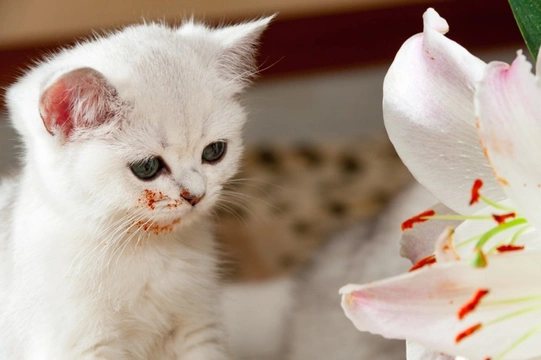
Why Lilies Are Poisonous to Cats and How Dangerous They Are
Most cat owners know that lilies are poisonous to cats, though it is easy to forget over time or for some to be unaware upfront. Sadly, some discover this the hard way when their feline friend falls ill after exposure.
Lilies are popular flowers in the UK, widely offered as potted plants, fresh cut flowers, or in bouquets from florists and supermarkets. There are nearly 100 well-known types of lilies, encompassing many that may not be immediately recognised as true lilies by most people. This increases the chances of cats encountering toxic varieties unknowingly.
Even cat owners who are aware that lilies are toxic might receive them as gifts from others unaware of the dangers, adding an inadvertent risk in the household.
This article explores exactly what makes lilies poisonous to cats, what parts of the plant are harmful, and how dangerous they truly are to your feline companions.
Which Lilies Are Poisonous to Cats?
All true lilies (Lilium species) and daylilies (Hemerocallis species), which are common in gardens and flower shops across the UK, are highly toxic to cats. Contrary to some myths, almost no true lily varieties are safe for cats. Some plants called lilies, like peace lilies or calla lilies, are not true lilies and do not cause kidney failure but may cause oral irritation instead.
What Parts of Lilies Are Toxic?
The entire plant is toxic to cats. This includes the flowers, leaves, stems, roots, pollen, and even the vase water that contains lily residue. The pollen poses a particular threat due to its abundance and ability to adhere to a cat’s fur.
A simple example is a cat brushing past a lily plant or bouquet, collecting pollen on its fur or paws, and then ingesting the toxin while grooming.
Why Are Lilies Poisonous to Cats?
The exact toxin responsible for lily poisoning in cats remains unidentified. However, it is well documented that ingestion causes severe and rapid damage to the kidneys, often leading to acute kidney injury (AKI). Even a small amount ingested by licking pollen or chewing the plant can be fatal.
How Dangerous Are Lilies to Cats?
Lilies pose an extremely serious risk to cats. Even minimal exposure to pollen or plant parts can lead to fatal kidney failure. Symptoms typically begin within 12–18 hours after ingestion and include vomiting, lethargy, drooling, and lack of appetite. Without swift veterinary treatment, the cat’s kidneys may sustain irreversible damage leading to death.
Lilies are common in homes and bouquets in the UK, often increasing the risk of accidental exposure. Cases of lily poisoning frequently require emergency veterinary care, and the fatality rate can be high if treatment is delayed.
What To Do If Your Cat Has Been Exposed to Lilies
If you suspect your cat has come into contact with lilies, seek veterinary attention immediately. It is critical not to wait for symptoms to appear, as kidney damage can begin rapidly after ingestion.
Some practical measures you can take include:
- Prevent your cat from grooming pollen off their fur by using a buster collar if available
- Gently and carefully wash or wipe off any visible pollen from their fur or paws
- Inform your vet about the possible lily exposure upon arrival
Veterinary treatment often involves inducing vomiting if ingestion was recent, administering activated charcoal to limit absorption of toxins, and providing aggressive fluid therapy. Recent studies suggest that outpatient treatment with subcutaneous fluids can sometimes be effective, reducing stress and cost, but close monitoring is essential regardless.
Blood tests and urinalysis will be needed to monitor kidney function during recovery, and follow-up visits are vital to detect any delayed effects.
Why It's Best to Avoid Lilies Around Cats
Given their extreme toxicity and the difficulty preventing accidental exposure—especially in multi-pet households or homes where guests bring flowers—it is safest to keep all types of true lilies and daylilies completely out of environments where cats live or visit.
Opting for non-toxic flowers and plants helps safeguard your beloved pets and provides peace of mind.
Remember, rapid veterinary intervention remains the most important factor in survival if exposure occurs. Never rely on home remedies or delay seeking professional help.
Are All Lilies Always Fatal to Cats?
Not all cases of lily ingestion lead to fatal outcomes, particularly when treatment is given promptly. Early vomiting or veterinary intervention can sometimes prevent severe kidney damage. However, even in these cases, the toxin’s effects can be serious and require medical care and monitoring.
Always treat suspected exposure as an emergency to maximise your cat’s chance of recovery.



